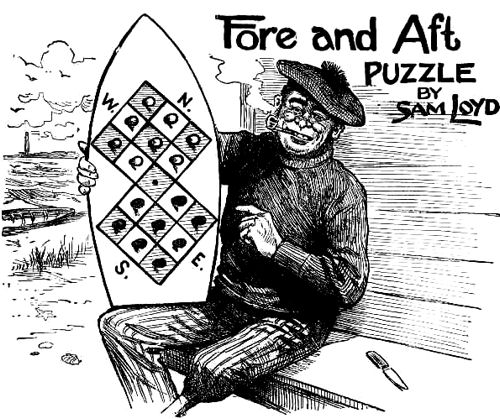



I TAKE OCCASION to call attention to the origin of a pretty puzzle game, or species of solitaire, which became quite popular in Europe. It is an English invention, in that it was originated by an English sailor, who spent forty years of his life at Sailor's Snug Harbor, on Staten Island, and whose proud boast was that he had sailed under Captain Randall, the founder of the institution,
The old sailor used to pick up quite a little bit of extra “baccy silver,” as he termed it, by selling the puzzles to visitors as fast, as he could whittle them out with a jack-knife. The game was brought out in London and enjoyed quite a run under the name of the English sixteen puzzle, but was never marketed on this side of the pond.
The object of the puzzle is to move the set of pegs from the right to the left and those on the left over to the right, like in the old 14-15 puzzle, from one square to another, with the additional privilege of jumping over a peg to a vacant hole, to expedite matters. The problem is to transpose the positions of the black and white pegs in the fewest number of moves, and the board is marked North, South, East and West, to enable puzzlists to record the sequence of their plays.
According to an eye witness, the old sailor was very proud of his expertness, and used to give purchasers a rule to perform the feat in the fewest number of plays. He was mistaken, however, in his rule, or it must be classed along with the lost arts, or perhaps the world has advanced since his time, for the methods given in the English puzzle books, as well as mathematical works, to be the shortest, are defective and may be shortened by several moves.
Remember that the pieces move square ways so as to change to an opposite color each time, and not like playing checkers.
This curious and interesting puzzle is given in the puzzle books to be solved in fifty-two moves, but many of our clever puzzlists succeeded in demonstrating the possibility of performing the feat in forty-seven plays. Some attempted to give a shorter method, but erred in counting the moves incorrectly.
As there is never more than one vacant square to be covered, it is only necessary to mention the direction of the play, as shown in the following sequence of forty-seven changes: East, West, West, East, South, North, North, South, East, South, West, North, West, North, West, South, East, East, South, North, West, North, South, South, East, North, West, North, East, West, South, West, North, East, South, East, West, West, East, South, North, South, and the feat is accomplished.
2.
Who was the most successful financier mentioned in the Bible? Noah, because he floated a limited company when all the rest of the world was in liquidation.
Why is a schoolmaster like the letter C? He forms lasses into classes.
Why are authors who treat of physiognomy like soldiers? Because they write about face.
I went into he woods and caught it, I sat down to look for it, and then I went home with it, because I could not find it. A splinter.
How did the whale that swallowed Jonah obey the divine law? Jonah was a stranger and he took him in.
Why is the polka like bitter beer? There are so many hops in it.
Why is your nose in the middle of your face? Because it is the center.
When may two people be said to be half-witted? When they have an understanding between them.
Why is a jailer like a musician? Because he fingers the keys.
Why is a field of grass like a person older than yourself? Because it's past-your-age (pasturage).
[Page 108]